Woodworking is a rewarding hobby that lets you make both useful and beautiful items. But, the many tools for woodworking can be hard to choose from for beginners. This guide will show you the key tools you need to start your woodworking journey. We’ll cover everything from saws to power tools to hand tools. This will help you set up your woodworking space, whether you like making furniture, doing carpentry, or just DIY projects.
Key Takeaways
- Discover the essential woodworking tools for beginners to start building projects
- Understand the different types of saws, power tools, and hand tools needed for woodworking
- Learn about the importance of having a solid workbench and essential hand tools like planes, chisels, and saws
- Gain insights on where to find quality woodworking tools, including vintage options
- Discover tips on prioritizing tool purchases and building a tool collection gradually
Introduction to Woodworking Tools
Starting in woodworking means getting to know the many woodworking tools out there. These tools fall into five main groups: cutting, finishing, assembly, measuring, and holding tools. Each group has its own set of tools that you’ll need.
Beginners should start with a basic toolkit. This includes the must-have tools from each category. With these tools, you can handle a variety of projects, from simple crafts to complex furniture.
As you get better and take on bigger projects, you can add more tools to your collection. Start with the basics and then add more as you go. Having the right tools lets you tackle different woodworking essentials with confidence.
| Woodworking Tool Category | Essential Tools for Beginners |
|---|---|
| Cutting Tools | Circular Saw, Jigsaw, Handsaw |
| Finishing Tools | Random Orbital Sander, Belt Sander |
| Assembly Tools | Power Drill, Screwdrivers, Clamps |
| Measuring and Marking Tools | Tape Measure, Combination Square, Marking Gauge |
| Holding and Securing Tools | Workbench, Vise, Clamps |
Learning about these key woodworking tools and adding to your collection will help you master beginner woodworking. With the right tools and practice, you can make your woodworking dreams come true.
Saws: The Cutting Force
Saws are key for any woodworking project. They help with everything from precise joins to cutting through big logs. Each woodworking saw has its own special job. Learning how to use them well is key to doing great woodworking.
Circular Saw
A circular saw is a must for woodworkers. It makes straight cuts on many materials. You can use it for ripping, crosscutting, or angled cuts by choosing the right blade.
Jigsaw
For cutting curves, a jigsaw is best. It has a thin blade for precise control in tight spots. Jigsaws are great for making complex shapes and cutouts that other saws can’t do.
Compound Miter Saw
A compound miter saw is great for precise angles and miters. It tilts the blade and turns the table for easy complex joints and moldings. This saw is perfect for projects like picture frames and crown molding.
Table Saw
The table saw is a main tool in many workshops. It has a big table and a rip fence for precise cuts. With different blades and accessories, it can do many cuts, like dado joints and bevels.
Bandsaw
A bandsaw is great for curved cuts and resawing lumber. Its continuous blade makes it easy to cut complex shapes. It’s a must-have for furniture making and projects needing curved cuts.
Handsaws
Even with more power tools around, handsaws are still vital. They offer precision and control, making them perfect for fine work and delicate cuts. Choosing the right saw blades for ripping, crosscutting, or both ensures top performance.
Picking the right saw and keeping blades sharp is key for great woodworking results. Knowing what each saw can do helps you work more efficiently and effectively.
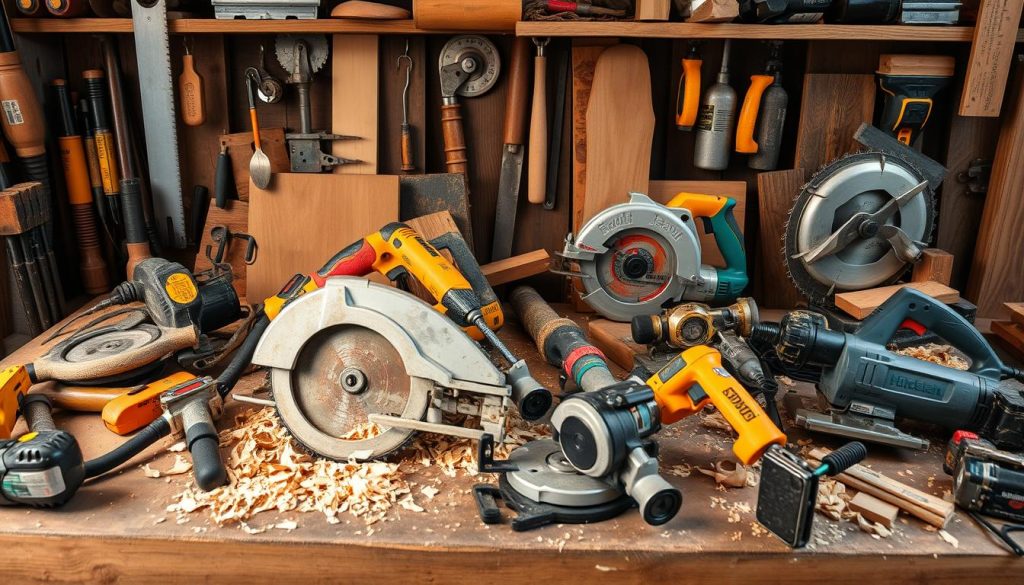
| Saw Type | Primary Use | Key Features |
|---|---|---|
| Circular Saw | Straight, clean cuts | Powerful, versatile, portable |
| Jigsaw | Intricate, curved cuts | Precise control, navigates tight spaces |
| Compound Miter Saw | Precise angle and miter cuts | Tilting blade, rotating table |
| Table Saw | Ripping and crosscutting lumber | Large table, rip fence, versatile accessories |
| Bandsaw | Curved cuts, resawing lumber | Continuous blade, navigates intricate shapes |
| Handsaws | Fine joinery, delicate cuts | Precision, control, tailored to specific tasks |
“Saws began as serrated materials, evolving with the use of iron becoming the preferred material for saw blades of all kinds.”
Measuring and Marking Tools
Getting things right in woodworking starts with precise measuring and marking tools. These tools are key for making projects that fit together perfectly.
Tape Measure
A tape measure is a must-have for woodworkers. It’s simple but crucial. Using the same tape measure for a project keeps measurements consistent and accurate.
Squares and Bevel Gauges
Squares, like combination and try squares, are vital for setting up 90-degree angles and more. Bevel gauges help you copy and set angles. They’re essential for joinery and precise cuts.
Marking Gauge
A marking gauge marks lines at a set distance from the edge of a piece. It’s key for perfect joinery. With a marking knife or pencil, it ensures your projects are spot on.
These tools work together to bring accuracy and consistency to your woodworking. Learning to use them well will lead to top-notch results in your projects.
| Woodworking Measuring Tool | Key Features | Best Uses |
|---|---|---|
| Tape Measure | Durable, accurate markings, locking mechanism | General measurement, layout, and marking |
| Combination Square | Adjustable, 90-degree reference, protractor | Checking squareness, layout, and marking angles |
| Bevel Gauge | Adjustable angle, holds settings | Transferring and replicating angles |
| Marking Gauge | Scribes lines at set distance, fine adjustment | Precise layout and marking for joinery |
“Accuracy in woodworking is crucial, with a focus on durability and precision of the tools used.”
Mastering these woodworking measuring tools will help you make projects that look professional.
Handheld Power Tools
Handheld power tools make woodworking faster, easier, and more precise. They help with drilling and finishing, making them key for woodworkers. These tools are a must-have for anyone starting out.
Power Drill
A power drill is crucial for woodworking fans. Choose a cordless one with at least 18 volts, like the DeWalt 20-Volt Max Lithium Ion Drill Driver/Impact Driver Combo Kit. It has over 36,000 five-star reviews on Amazon.
Random Orbital Sander
A random orbital sander gives you a smooth finish without swirls. It moves in circles and orbits for an even look. The Bosch Sander has a soft body and accepts hook-and-loop abrasives for easy sanding.
Router
Routers are versatile, perfect for edge profiles and joinery. They range from 1-3/4 to 3-1/4 horsepower. A full-size router like the Makita D-Handle Router is a solid choice. For smaller projects, the Bosch Colt 1.25 HP Variable-Speed Palm Router Combination Kit is easy to use.
Quality handheld power tools can improve your woodworking skills. With the right power tools, power drill, orbital sander, and router, your projects will look great and work well.
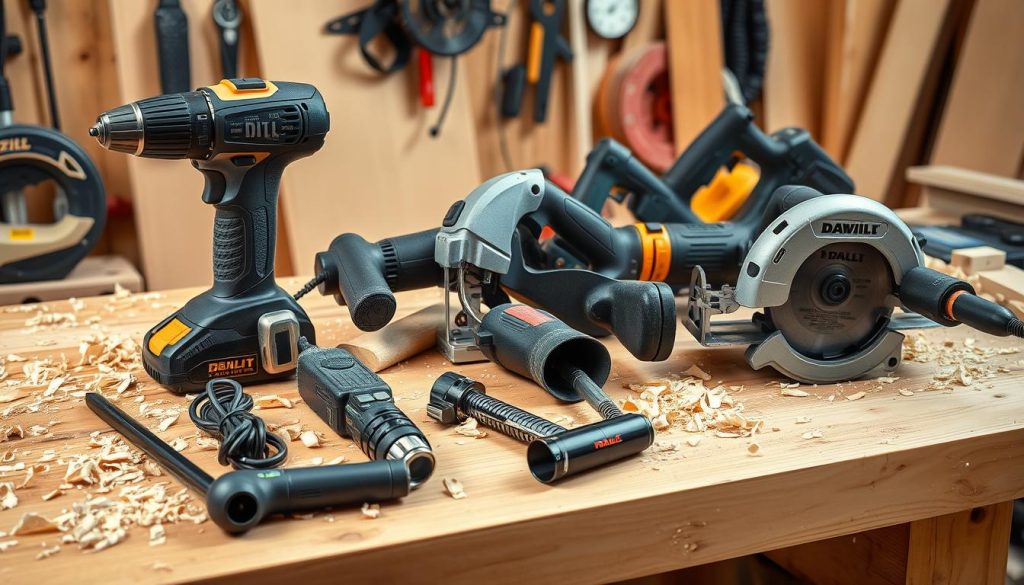
Hand Tools for Precision
Woodworking needs a gentle touch. Hand tools are key for precision and control. Chisels, mallets, and block planes are essential for any woodworking shop.
Chisels
Chisels help woodworkers fine-tune joints and shape details. A set of 1/4″, 1/2″, 3/4″, and 1″ chisels covers many tasks. Chris Gochnour suggests a high-quality set for better work quality.
Mallets and Hammers
Mallets and hammers are vital for driving chisels and putting projects together. Wooden mallets are classic, but some prefer smaller, specialty mallets. A claw hammer is great for light work and adjustments.
Block Plane
The block plane is great for trimming and chamfering. Mario Rodriguez recommends low-angle block planes for their control and less chatter on wood.
Sharpening Tools
For sharp hand tools, you need sharpening supplies like waterstones and honing guides. Chris Gochnour says sharpening tools well is key for top results.
Learning to use hand tools well will improve your woodworking. It lets you do projects with precision power tools can’t match.
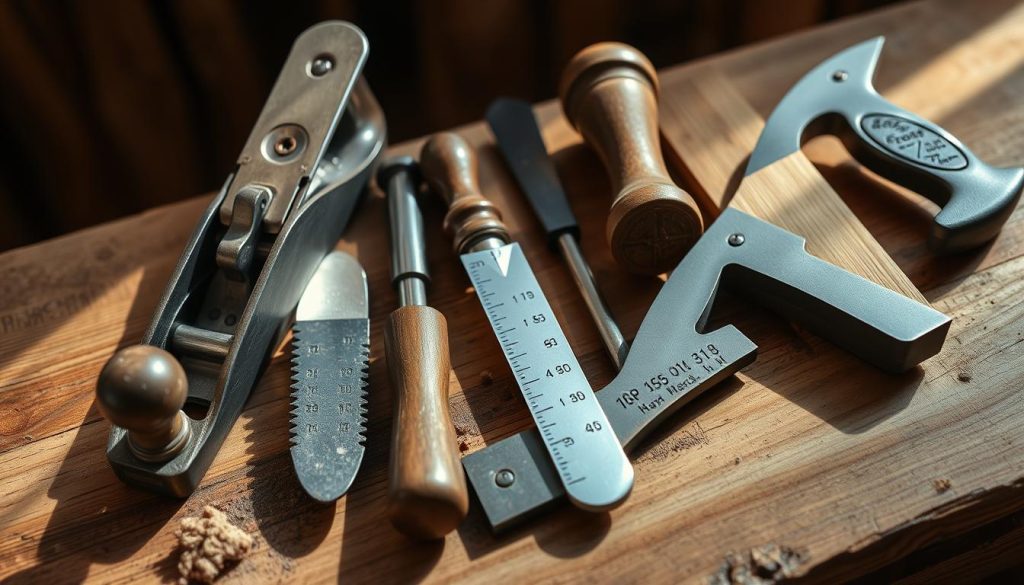
“Investing time in learning proper hand tool techniques will elevate your woodworking skills.” – Chris Gochnour, woodworking expert
Stationary Woodworking Tools
Stationary power tools are key for a great woodworking shop. They bring precision and power to your projects. The table saw and planer are two must-have tools.
Table Saw
The table saw is vital for woodworking. It’s great for ripping and crosscutting lumber with precision. You can choose between a cabinet saw or a contractor saw, based on your space and budget.
Cabinet saws have more power and stability. Contractor saws are portable and cheaper. A good table saw opens up new possibilities in woodworking.
Planer
The planer is another crucial tool. It flattens and makes boards the same thickness. It’s pricier than handheld tools but worth it for quality woodworking.
Stationary tools like the table saw and planer cost a lot. But they’re key for precise and quality woodworking.
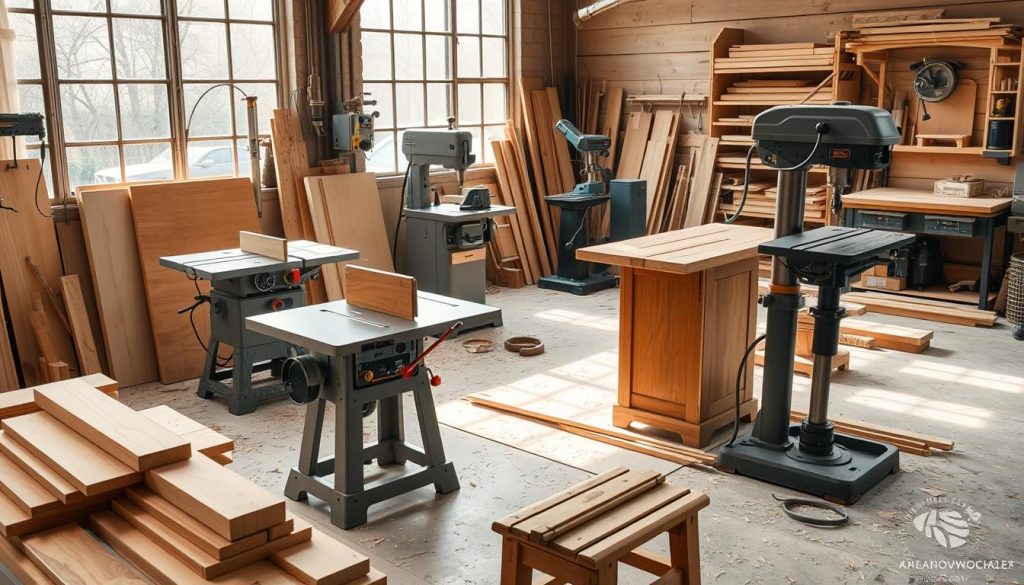
Clamping and Joining Tools
Woodworking requires clamping and joining tools for precise and strong results. These tools are key for keeping your pieces together during various steps. They help in making sure your joints are accurate and your work is solid.
There are many types of clamps, each for different tasks. Start with a selection of pipe clamps, bar clamps, and strap clamps in various sizes to meet your needs. These tools are very helpful, keeping your pieces in place during gluing, nailing, screwing, and more.
- Pipe clamps have a lot of clamping power and can be extended with more pipe for bigger projects.
- Bar clamps give a stable grip and adhesive-backed felt pads on the jaws prevent dents.
- Strap clamps are great for odd-shaped pieces and assembling picture frames without the clamps sticking.
Joining tools are also crucial for making strong wood connections. Pocket hole jigs are a favorite for woodworkers. They make joining boards fast, efficient, and easy for beginners. These jigs help you put in hidden fasteners, making your projects look better.
Whether you’re experienced or new to woodworking, good clamps and joining tools are key. Look through the many options and pick the ones that fit your needs and projects.
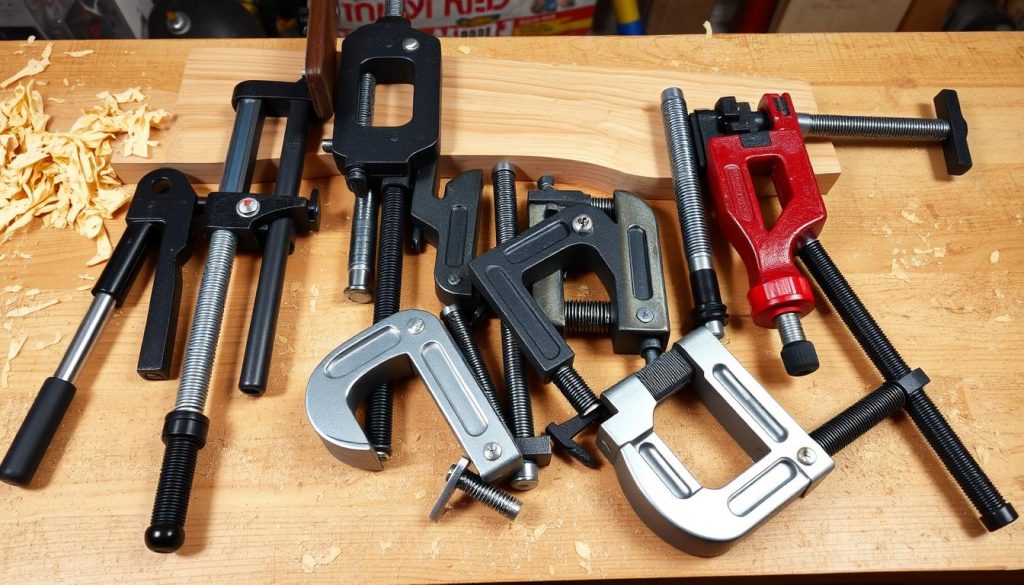
“Clamps are the woodworker’s third hand – they hold your work securely in place, allowing you to focus on the task at hand.”
Finishing and Sanding Essentials
Getting a smooth finish is the last step in woodworking. A random orbital sander is key for this, smoothing out surfaces with circular and orbital patterns. Use different grits of sandpaper with it to go from rough to fine easily.
Mastering Sanding Techniques
Learning how to sand right can make your woodworking look better. Begin with sandpaper of lower grit (80-100) to fix big flaws. Then, move to higher grits (150-220) for a smoother finish. Sanding blocks help you get a smooth surface with the 220-grit sandpaper.
Always sand with the wood grain to hide marks from tools. This detail makes a big difference in your finished piece’s quality.
For big projects, a 4-inch by 24-inch belt sander works better than a 5-inch random orbital sander. Also, use 1-1⁄2-inch square battens to keep panels aligned while sanding.
“Sanding is the key to a flawless finish. Take the time to master these techniques, and your woodworking projects will look like they were created by a true professional.”
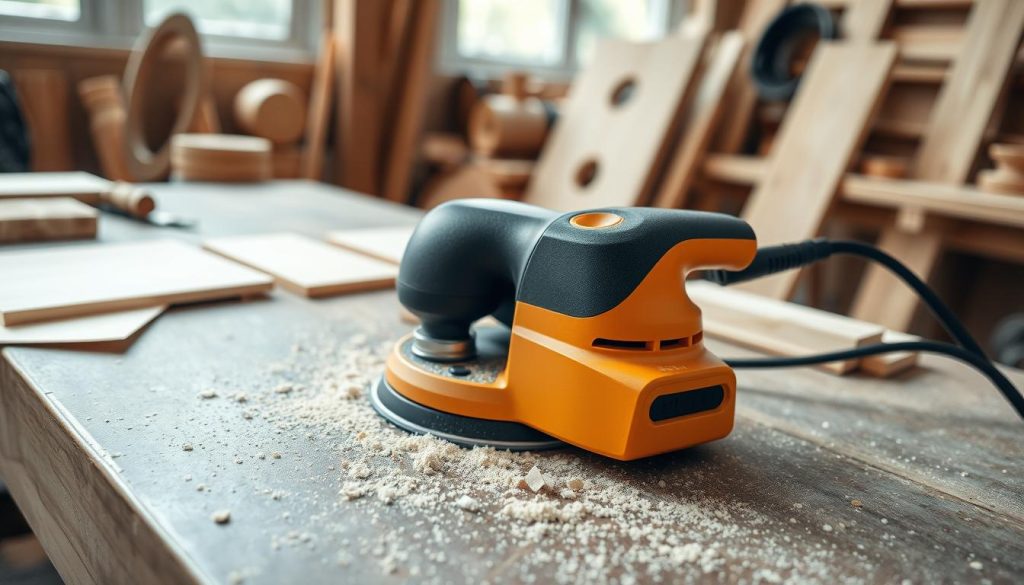
Using a random orbital sander and improving your sanding skills can turn simple projects into masterpieces. Always wear safety gear like a dust mask when sanding. With the right tools and skills, you’ll make professional-quality finishes easily.
Woodworking Tools for Specific Projects
As you get better at woodworking, you might need more specialized tools for certain projects or techniques. These project-specific tools let you explore new creative paths. They help you take on more complex woodworking projects once you’ve learned the basics.
A dovetail saw is great for making the detailed joints in fine cabinetry and furniture. A scroll saw is best for doing delicate fretwork and precise cuts. And a wood lathe is key for making unique, round pieces like bowls, spindles, and baseball bats.
These specialized tools might not be a must-have for beginners, but they can really boost your woodworking skills. When planning your next project, think about which specialized tools could get you the results you want. By getting the right tools, you can make woodworking masterpieces that stand out.
| Tool | Application |
|---|---|
| Dovetail Saw | Intricate joinery, fine cabinetry |
| Scroll Saw | Delicate fretwork, intricate cuts |
| Wood Lathe | Shaping bowls, spindles, baseball bats |
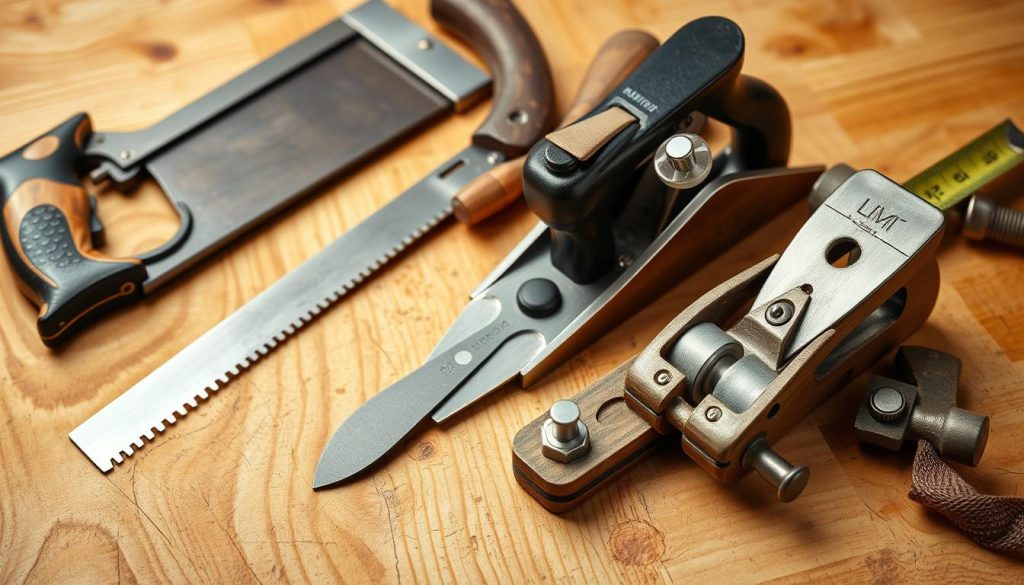
“Investing in the right tools for the job can help you create truly remarkable woodworking masterpieces.”
Tool Storage and Organization
As your woodworking toolkit grows, keeping your tools safe and easy to reach is key. Using tool chests, cabinets, or racks helps a lot. Labeling drawers and shelves keeps everything tidy and efficient in your workshop. Pegboards, magnetic bars, and other solutions can help you use your space better.
Having your tools organized makes your work flow better. You’ll find the right tool fast when you need it. You have tools like a #3, three #4s, two #5s, and are looking for a #7. You’ve started with a small plywood shelf system but need more space now.
A workbench that’s 20″-24″ wide is good for easy tool access. A Dutch tool chest is great because it’s compact but holds a lot. Building a wall cabinet is also a good idea for storing all your tools.
| Tool Storage Solution | Dimensions | Benefits |
|---|---|---|
| Large Tool Chest | 98.5cm length, 55.0cm depth, 61.0cm height | Provides rust protection for tools due to humidity control |
| Pegboard and Shelves | N/A | Maximizes workshop organization and tool accessibility |
| 19th-Century Tool Box | Designed to hold 300 tools | Offers comprehensive tool storage in a traditional design |
To prevent rust, use moisture absorbers, large sealed cabinets, and keep sharp tools in their cases. WD-40 Specialist Corrosion Inhibitor is great for protecting tools from rust. Tests show it works for over two years in wet conditions.
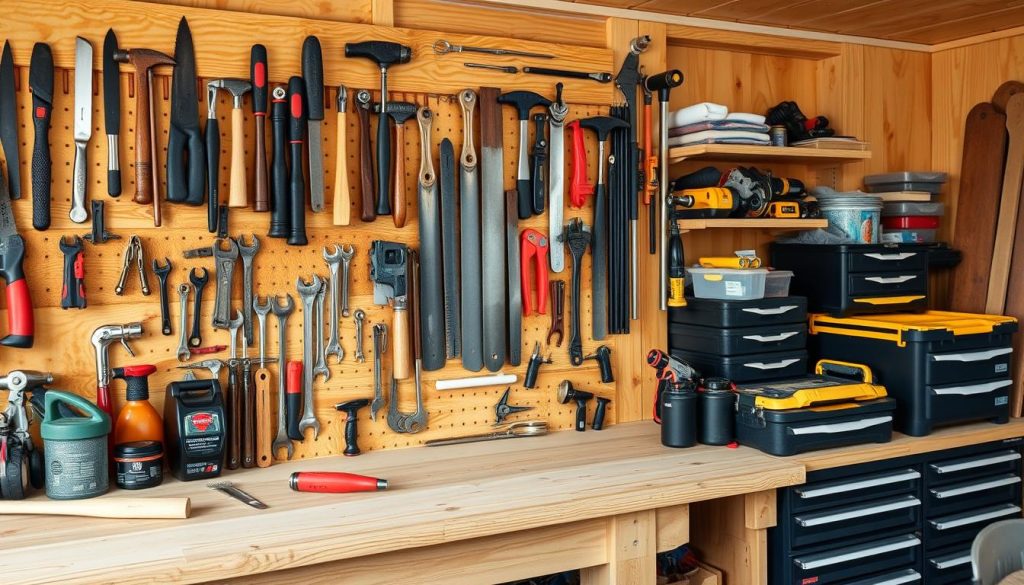
Choosing a custom or pre-made tool chest can make your workshop better. It lets you work more efficiently and keeps your tools safe.
Safety Gear for Woodworking
Woodworking can be a rewarding hobby, but safety comes first. It’s key to invest in personal protective equipment (PPE) for your safety. Safety glasses and hearing protection are crucial to keep you safe and focused.
A good dust mask or respirator is a must-have for woodworkers. Look for masks that filter out at least 95% of particles. For better protection, consider an RZ mask with filters that block 99.9% of particles.
Protecting your hearing is also vital. Power tools can be very loud, so wear hearing protection with an NRR of at least 20 dB. Ear muffs are a budget-friendly and effective choice.
Keeping your eyes safe is crucial too. Safety glasses or goggles protect against wood chips and debris. Make sure they have scratch resistance and UV protection for comfort and safety.
Keeping your workshop safe is important too. Manage tripping hazards and wear sturdy work boots to protect your feet. Avoid loose clothing and jewelry to prevent getting tangled in tools.
Focus and awareness are key to woodworking safety. Know how to use your tools and stay alert to reduce accidents. Always put safety first in your woodworking.
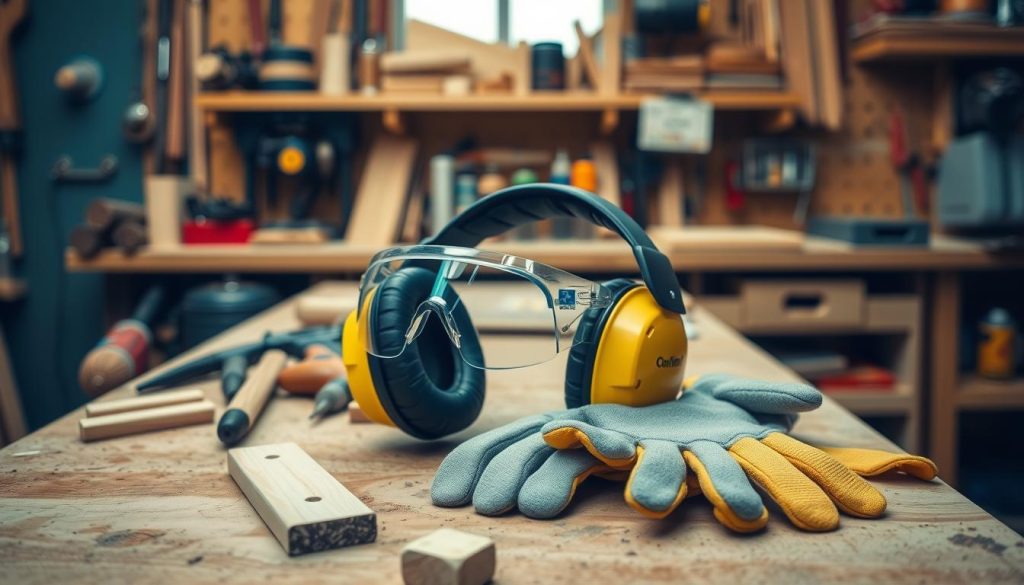
“Prioritizing safety in the woodworking workshop is the key to unlocking the full potential of this rewarding hobby.”
Buying Used Woodworking Tools
In woodworking, quality tools are a big investment. Savvy beginners look for used and second-hand options to start. You can find used tools in great shape at a lower cost by checking local ads, estate sales, and online.
When buying used tools, inspect them well. Look for wear, damage, or poor upkeep like rust or missing parts. Avoid items that seem too cheap, as they might need expensive fixes. With careful inspection and patience, you can find great tools at a good price.
An experienced woodworker bought a Powermatic 64A saw for $500 and a Powermatic PM66 for $1,200. This smart buying of second-hand tools helped the author build a great tool set without spending too much.
Buying used tools saves money and offers long-term value. Many tools are made to last, with proper care they can work well for years. The author found these tools durable, needing only occasional repairs.
When looking at used tools, bring a friend and share the meeting details. Ask for more pictures and info from the seller. Check the tool for damage, rust, and smooth operation. Knowing local prices helps you make smart choices and avoid paying too much.
Buying new tools has its perks, like warranties and support. Yet, finding great used tools at a good price is rewarding. It’s also a green choice, promoting reuse and recycling.
Looking for used tools can be exciting, whether at garage sales, auctions, or online. With research and patience, you can gather a top-notch set of woodworking tools. These tools will help you for many years.
Essential Woodworking Tool Maintenance
Keeping your woodworking tools in top shape is key for getting professional results and making them last longer. Regular tool maintenance like cleaning, lubricating, and sharpening is vital. It helps your saws, planes, chisels, and other gear work their best.
Start by cleaning your tools right after you use them. Get rid of sawdust, resin, or debris that can affect their performance and shorten their life. Use a soft cloth, brush, or compressed air to clean all moving parts and surfaces. For extra protection, put a thin layer of machine oil or rust-preventative lubricant on metal parts.
Sharpening your blades is also crucial for woodworking tool upkeep. Dull edges lead to poor cuts and can be risky. Get a good sharpening system like a bench grinder or sharpening stones. Learn how to sharpen your chisels, plane irons, and saw teeth properly. Check the manufacturer’s guidelines for the best sharpening angles and how often to do it.
| Tool Maintenance Tip | Benefit |
|---|---|
| Regular Cleaning | Ensures longer tool lifespan and optimal performance |
| Frequent Sharpening | Delivers clean, precise cuts and safer operation |
| Proper Storage | Prevents rust, corrosion, and damage to tools |
Lastly, store your tools in a clean, dry place with the right humidity level to stop rust and corrosion. Use tool chests, cabinets, or wall-mounted racks to keep your gear organized and safe when not in use.
By spending a bit of time and effort on tool care, you can make sure your woodworking tools stay in great shape. They’ll perform their best for many years.
Budgeting for Woodworking Tools
Setting up a woodworking workshop takes a big chunk of money, especially for power tools. As a beginner, making a realistic budget is key. Start with the basics like hand tools and small power tools. Then, add more tools as you get better and take on bigger projects.
Buying used tools is a smart move to save money. You can get quality tools that last for years without spending a lot. Remember, the right tools are worth the investment, so pick the best you can afford.
- Set a limit on how much you’ll spend on each tool to avoid spending too much.
- Take time to look for deals on quality used tools through research and networking.
- Keep an eye out for ways to save money, like discounts, cashback, and online sales.
When planning your woodworking budget, balance your current needs with your future goals. Start with the basics and add more tools as you grow. With careful planning, you can build a workshop that fits your tool budgeting, woodworking tool costs, and tool investment over time.
“Investing in quality tools is essential for any woodworker, as they serve as the foundation for creating lasting, high-quality projects.” – Woodworking Expert, John Doe
Conclusion
Getting the right woodworking tools is key to making great projects. This guide covered the must-have tools for beginner woodworking. Start with the basics and focus on quality over quantity. You can also look for used tools to save money.
With the right woodworking essentials and safety in mind, you’re ready to get creative. This guide has given you the tools and knowledge to pick and care for your tools. It’s perfect for both new and experienced woodworkers.
Keep exploring and improving your woodworking tools and skills. Becoming a skilled woodworker takes time, but it’s worth it. Enjoy the process, stay safe, and let your creativity flow.